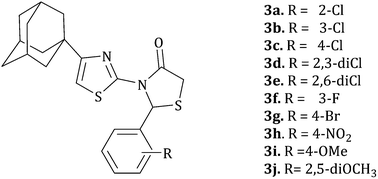4-Thiazolidinone derivatives as potent antimicrobial agents: microwave-assisted synthesis, biological evaluation and docking studies
Abstract
As a part of our ongoing research in the development of new

Maintenance work is planned for Wednesday 1st May 2024 from 9:00am to 11:00am (BST).
During this time, the performance of our website may be affected - searches may run slowly and some pages may be temporarily unavailable. If this happens, please try refreshing your web browser or try waiting two to three minutes before trying again.
We apologise for any inconvenience this might cause and thank you for your patience.
* Corresponding authors
a
Department of Medicinal Chemistry, School of Pharmacy, Aristotle University of Thessaloniki, Thessaloniki, Greece
E-mail:
geronik@pharm.auth.gr
Fax: +30 23 1099 7612
Tel: +30 23 1099 7616
b
Mycological Laboratory, Department of Plant Physiology, Institute for Biological Research Siniša Stanković, University of Belgrade, Bulevar Despota Stefana 142, Belgrade, Serbia
E-mail:
mris@ibiss.bg.ac.rs
Tel: +381 1 1207 8419
c
Institute of Molecular Genetics, IGM-CNR, via Abbiategrasso 207, Pavia, Italy
E-mail:
maga@igm.cnr.it
Fax: +39 38 2422 286
Tel: +39 38 2546 354
d Academy of Scientific and Innovative Research, New Delhi, India
e
Medicinal and Process Chemistry Division, CSIR-Central Drug Research Institute, Lucknow, India
E-mail:
anilsaxenagiper@gmail.com
Tel: +91 52 2400 4280
As a part of our ongoing research in the development of new

 Please wait while we load your content...
Something went wrong. Try again?
Please wait while we load your content...
Something went wrong. Try again?
E. Pitta, E. Tsolaki, A. Geronikaki, J. Petrović, J. Glamočlija, M. Soković, E. Crespan, G. Maga, S. S. Bhunia and A. K. Saxena, Med. Chem. Commun., 2015, 6, 319 DOI: 10.1039/C4MD00399C
To request permission to reproduce material from this article, please go to the Copyright Clearance Center request page.
If you are an author contributing to an RSC publication, you do not need to request permission provided correct acknowledgement is given.
If you are the author of this article, you do not need to request permission to reproduce figures and diagrams provided correct acknowledgement is given. If you want to reproduce the whole article in a third-party publication (excluding your thesis/dissertation for which permission is not required) please go to the Copyright Clearance Center request page.
Read more about how to correctly acknowledge RSC content.
 Fetching data from CrossRef.
Fetching data from CrossRef.
This may take some time to load.
Loading related content
